Slightly Included Diamonds (With Real Examples & Insights)
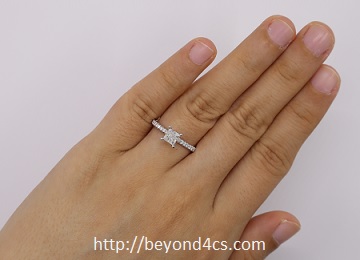
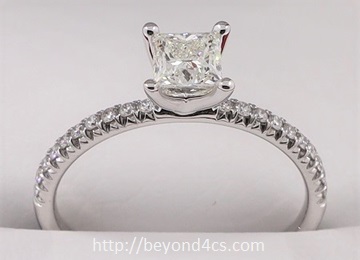
My wife wearing a stunning SI1 princess cut diamond ring that only cost $2000!
When it comes to buying a diamond engagement ring, the slightly included grades (comprising of SI1 and SI2) are some of the most misunderstood aspects of diamond clarity.
Very often, people wrongly assume that a slightly included diamond will always cause durability issues or that they would always be able to see inclusions with their naked eyes.
So, what exactly is a slightly included diamond? What’s the difference between SI1 and SI2 clarity grade? Should you stay away from SI1 and SI2 grades when buying a diamond online?
If you are thinking about buying a slightly included diamond, you’ve come to the right place. In this write up, you will find out how to shop for lower clarity diamonds and see real life examples of slightly included diamonds.
Let’s get started!
What Does Slightly Included Mean? Should You Buy SI Diamonds?
The grading definition of slightly included refers to diamonds that have easily noticeable inclusions when viewed under 10X magnification by a trained grader. Here, I want to emphasize that grading is performed in a controlled environment and the keyword is “10x”.
Just because a diamond has inclusions that can be seen under magnification doesn’t mean that you will be able to see inclusions in day-to-day environments with an unaided eye.
Here’s one such example of an SI1 graded princess cut diamond. As you can see below, the crystal and cloud inclusions can be seen clearly under the table facet.
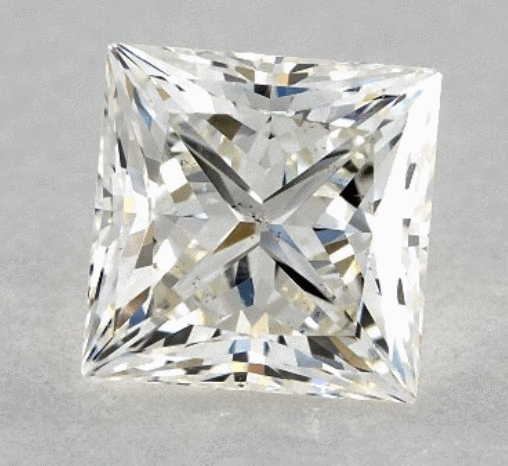
Click this link to view the full diamond details and interact with it for yourself.
Now, would it surprise you if I told you this is the SAME exact stone I picked for the engagement ring you’ve seen earlier?
Under magnification, the inclusions look obvious but that’s the point isn’t it? You want to see every single detail to understand what you are buying and the magnified videos are a useful tool to do this.
In reality, these inclusions are invisible to the naked eyes and you won’t see any inclusions in the diamond ring when it is worn on the hands. Don’t believe me? Watch this video for yourself and look out for any signs of the inclusions as I review the diamond ring.
In my opinion, buying a slightly included diamond is one of the best ways to getting more value for your money. If you are working with a limited budget, buying an eyeclean SI diamond allows you to maximize carat weight without compromising on the diamond’s appearance.
However, the caveat here is that you need to put in some extra effort to select the ones which are eye-clean (no visible inclusions with the naked eye) and never shop blindly.
to view the diamond at James Allen.
Let’s Take a Look at Slightly Included II (SI2) Diamonds
Before I go further, I want to point out that individual clarity grades can fall within an “acceptable band”. For example, a graded stone could be on the higher band of SI2 (closer to SI1) or on the lower band of SI2 (closer to I1).
Ultimately, it is the amount and type of inclusions which causes a diamond to be placed in a particular clarity grade. Very often, the locations of flaws will play a big role in defining whether a diamond is eye clean or not.
Clarity Grading is Relative to Carat Size
Do note that your game plan might have to change if you are considering SI diamonds that are larger than 1.50 carats. When it comes to bigger stones, a higher clarity grade is usually required for the diamond to stay eye-clean.
For educational purposes, I am going to show you some examples of diamonds you should look out for and those that you should avoid. First of all, let’s take a look at the following emerald cuts which are both graded with an SI2 clarity rating.
This SI2 emerald cut diamond has inclusions well spread out across the gem and is eye-clean.

This H SI2 diamond has big black crystal inclusions under the table facet which are obvious to the naked eye. To make things worse, the inclusions are also reflected multiple times by the pavilion facets.
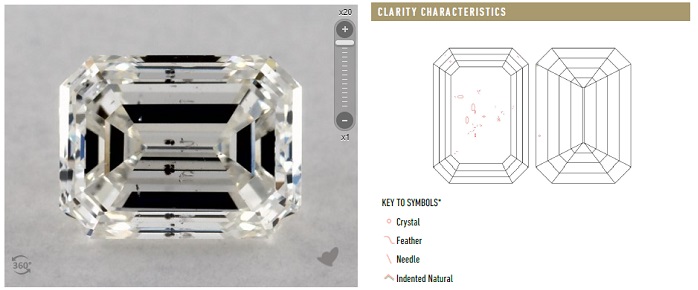
Comparisons of SI2 Clarity Round Brilliant Cut Diamonds
Due to the nature of the brilliant cut, round diamonds can be more forgiving with lower clarity grades. With better optical performance, the fire and scintillation of an ideal cut round diamond can help mask inclusions compared to step cuts like the emerald or asscher.
However, that’s not to say we can just go out and randomly pick the first ideal cut round diamond we see. You still need to exercise caution! Check out some examples of slightly included diamonds below and you’ll understand why.
This K color SI2 round diamond has super obvious black crystal inclusions which stands out like a sore thumb.
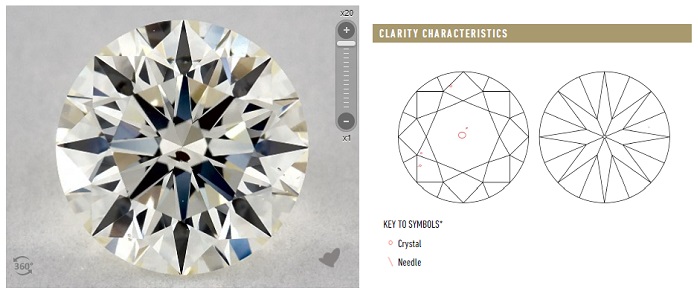
This H SI2 round diamond has a large feather extending dangerously from the girdle into the body and the unsightly knot inclusion kills it for this example…
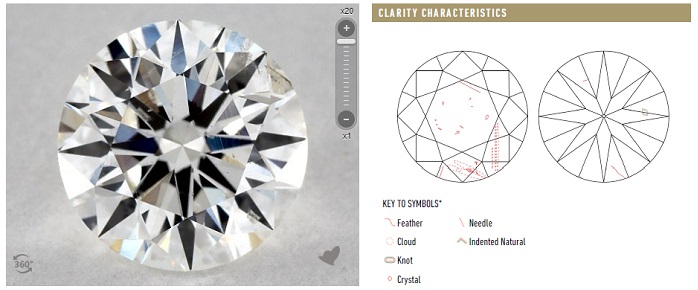
Here’s an eye-clean G SI2 diamond even though the grading report shows a scary looking plot. The twinning wisps in this diamond is nicely scattered around the stone.
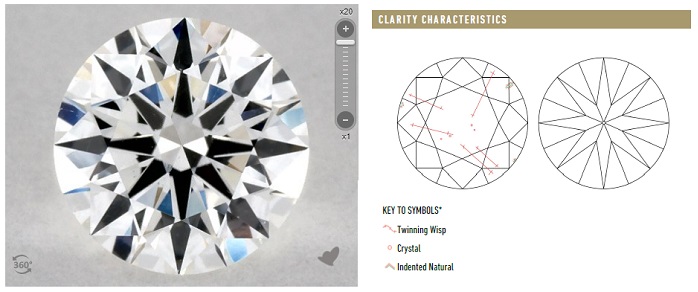
From these examples, you can see that a grading report only grades and maps the diamond’s inclusions. Without seeing the actual diamond, there’s no way you can determine how the inclusions will impact a diamond’s beauty.
Real Life Examples of SI1 Clarity Diamonds With Videos And Photos
By now, I hope I had driven home the point that viewing a magnified photo or video is mandatory in helping you make educated selections. I need to remind you that the images you’ve seen so far had all been magnified many times. In real life, the inclusions are not as noticeable as you think they are.
When browsing through diamonds, you can make use of the clarity plot as a reference to compare images and also as a tool to orientate yourself to the locations of the flaws.
To complete this round up, here are some examples of slightly included diamonds (SI1) which aren’t eye clean. I will start with a “bad” example of an L color SI1 diamond with a cluster of crystal and cloud inclusion that spoils the overall appearance.
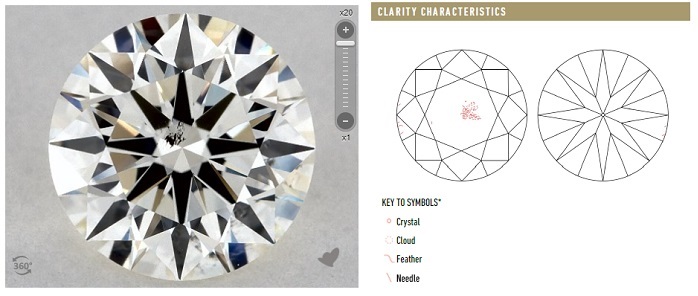
One other mistake that consumers make is the assumption that twinning wisps are the “best” kind of inclusions to have as they are usually whitish or transparent. As you can see in the I SI1 diamond below, the twinning wisps are stark black!
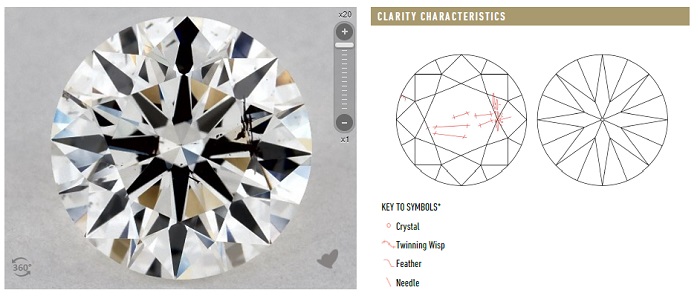
Surprise! This F SI1 round diamond actually yielded an eye clean diamond even though the plot is relatively messy.
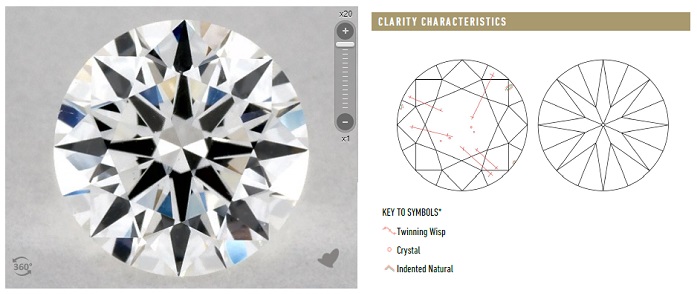
For people who want to maximize their budget for a bigger and better cut stone, clarity is an aspect you can compromise on. You don’t really need a VVS1 diamond when an SI1 diamond can look just as good in person. The only catch here is that you need to do your homework and shop at the right places before making a purchase.
Remember, diamonds are not created equal. Even if 2 stones look very similar on a piece of paper, they might look very different in real life. As you can see above, inspecting a diamond with magnified pictures or videos will reveal a lot of details about the stone.
Finally, don’t be afraid of buying diamonds in the lower clarity grades. It is perfectly OK for a diamond to have inclusions! As long as you are clear about what you are doing and had examined it under magnification, you won’t have a shocker when you receive the stone.
With that, I hope you found the insights in this article useful. If you haven’t yet, make sure you check out our step by step guide on choosing a diamond. As always, feel free to ask questions or leave us a comment below.
Related Articles
Leave A Comment














18 Comments
I have an SI2 1.5 F color diamond that has two big pin points in the table…cannot be noticed unless under magnification…can only see with naked eye after staring for a while…is it worth buying for 10200 out the door?
Well, the stone isn’t eyeclean based on your observations. I would dump the stone and keep looking.
I have a 1.26 ct H excellent cut SI2. The diamond is eye clean face up and has beautiful shine. That said, if I stare at the diamond from the side angle at point blank range I can see the inclusion alongside the prong area. It is slightly concealed in this location and like I said, cannot be seen face up. The GIA plot is nearly flawless except for this side crystal. Is it worth the extra couple grand (at least) to upgrade the clarity rating assuming all else is equal?
Depends on how much it matters to you. If seeing the inclusion by its side is affecting your enjoyment of the diamond, change it. I would say that most people only care about the face up view and not the profile view.
sir,
I’m in india. My Budget is 1 lakh rupees, including a ring mount. around $1500. Sir, i would be thrilled if u could guide me as to which would be the best solitaire diamond i can buy. also, are si diamonds real? some people had told me that they could be fake diamonds as they are too cheap.
Please do guide me.
I don’t really understand your question. SI diamonds are definitely real diamonds. The term “SI” simply refers to a category of diamonds with a specific clarity rating.
What’s your opinion of the following diamond from James Allen? If it doesn’t match up to your standards, can you find me another option for around 10 thousand dollars?
I don’t see any urls or links to the stone. Can you check that you entered the comment correctly? For what’s its worth, this article should address some of your questions when shopping for a 10k wedding ring.
Hi! I bought a ( pre owned ) diamond ring from a seller who sales a lot of pre owned jewlery. The diamonds were described as J color and SI to P1 in clarity. On the centre there is a 7 mm square with 9 princess cut diamonds, plus other small baguette cut d. on the side of the ring. Well, the colour seems to be slightly yellow only under a yellow light source, in the day light the colour appears to be candid like snow ( I will be waiting till spring when the sun come out to se them in the direct sun light ). As for inclusions I’m not able to see any even with 30 x magnification ( but with a low quality loupe ) – maybe because d. are small ( total weight of d. is about 0.70 ct ) and/or well cut. I suppose many people won’t buy them after reading J/ Si-I1 ( declared by the seller ) but they look really beautiful. So I1 seems to be advisable at least for small pieces. Last but not least the d. on the picture seemed much more yellow than the actually look like under normal light. Have I found a honest seller?
It’s unlikely you found an honest seller if the piece came without a reliable grading report from a 3rd party lab. For someone in the trade, P1 is not a proper term used and also, you probably don’t know what you have on hand or how to examine jewelry correctly.
Hi Paul, I am purchasing diamond ring for my wife. It is our 40th wedding anniversary. Under 10X view I did not see any inclusion from the top. I did not look at the sides or bottom. I have the GIA number and looked it up and saw the inclusions. It is a 1.90 carat, F Color, SI1 Clarity, Excellent Cut, Excellent Symmetry, Excellent Polish and Faint Florescence, It is a big investment and I wanted a quality diamond for my wife. My only worry was the SI1 Clarity, but that kept the cost down and it looked good.
The GIA number is 5181827243.
https://www.gia.edu/report-check?reportno=5181827243
Any thoughts would be appreciated. Thank You Raffi
I can tell you that the mediocre proportions would have instantly cause me to “fail” the diamond. I won’t even bother wasting time and effort to look at tangible data when light physics dictates performance issues here. As for clarity, the plot itself is not useful because you do need to judge the diamond on a case by case basis based on its appearance. There’s zero tangible data here.
In answer to the answer you gave to me: the ring I bought is a pre owned ring, this vendor buys lots of used jewelry abroad, and sells it back in Poland, there is no sense to give an independent grading report from third part labs like GIA because of the cost involved and to keep prices reasonably low.
I think I have found the answer in your articles, since these are small diamonds, it is possible to have even a P1 eye clean because of the small size as inclusions become noticeable only if the size grows! Even so the diamonds have a good sparkling and fire, as for the color, I have yesterday bought a F VS1 emerald cut diamond, which is, of course much brighter compared to the others.
Prices are “low” for a reason when buying diamonds without a GIA grading report. In reality, they are going to be MORE expensive than a properly graded diamond 99% of the time. Jewelers who take advantage of misrepresentation will always say the same excuse “Oh, sending the diamond to GIA is going to end up costing you more.”
It’s a load of bullshit. The GIA report protects the consumer and not buying a diamond ring with one is asking to get ripped off. And deserving so, for people who knowingly have this knowledge and still choose to ignore the advice.
You would be definitely right if we were speaking about a solitaire 0.70 carat diamond. We are speaking about 9 0.05 carat princess cut clutter setting a many small baguette diamond set on the ring band. A third party like GIA grading report will surely surpass the value of that kind of ring, bought in after market. I think no one vendor offers a third party grading report for a lot of small tiny diamonds, it would be like repairing a chipped 0.10 carat diamond. Of course if I had been buying a solitaire ring for thousands of dollars I would pretend to have it graded by GIA
You are absolutely right. If you are buying melees or accent diamond rings, then the grading makes no economic sense. You just have the trust what the vendor says about their goods. So, do you trust them? If you do, you probably won’t be asking questions here.
This article will have more info: https://beyond4cs.com/jewelry-guide/what-are-accent-diamonds/
Hi, I inherited my mom’s jewelries, and with that her wedding ring, I took it to the jeweller and he told me that the kind of cut is actually not worth anything, and he said is a one cut. not sure what that is. I was kinda surprised. Either way i’m keeping it. it’s my mom’s and that’s the important part of it.
Diamonds have little resale value to begin with. If it is an old cut, I think he is referring to the single cut. The underlying value of the diamond is determined by the quality of the diamond and for what’s its worth, the jeweler has probably saw diamonds with junk tier quality in terms of the 4cs.